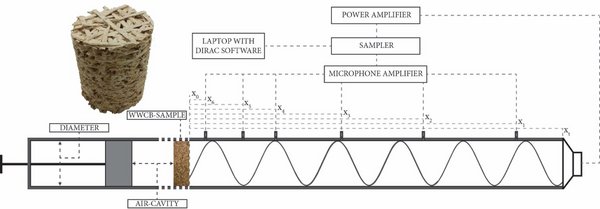
Name of student: B. (Bram) Botterman
Supervisors: prof.dr.ir. H.J.H. (Jos) Brouwers, dr. ir. M.C.J. (Maarten) Hornikx, dr. Q. (Qingliang) Yu and ir. G.C.H. (Guillaume) Doudart de la Grée
Chairs research belongs to: Building Acoustics & Building Materials
Strategic area: Sound absorbing materials
Project year: 2016
The wood wool cement boards (WWCB), produced since 1920 and consisting of wood wool mineralized by Portland Cement, are mainly used as in- and outdoor ceiling material and sound barriers. The boards possess a high fire resistance, are having a high durability and low maintenance, hence are still popular nowadays. Due to the high open porosity and the internal pore structure, the boards can acoustically be considered as porous absorbers. Although its sound absorption coefficient values have been measured previously, no systematic study exists explaining the sound absorption behaviour of the WWCB. This study aims therefor to characterize, model and finally optimize the sound absorption of these boards.

The tested WWCBs are made of three different strand widths (1.0, 1.5 and 2.0 mm) and different thicknesses. The main difficulty lies in the inhomogeneity of the WWCB; the samples taken from the different commercial boards do not only greatly differ in density, but also in wood-to-binder ratio. Different impedance models, able to predict the normal sound absorption values of porous materials, have been analysed and their suitability for the WWCB has been evaluated. It is concluded that the Johnson-Champoux-Allard (JCA) model was found to be most appropriate to fit the measured normal incidence sound absorption values in the impedance tube. This model takes into account five parameters; the open porosity, flow resistivity, tortuosity and the viscous and thermal characteristic lengths.
Finally, by creating relations between the bulk density and the five input parameters, it can be concluded that it is possible to increase and optimize the sound absorption of WWCB.